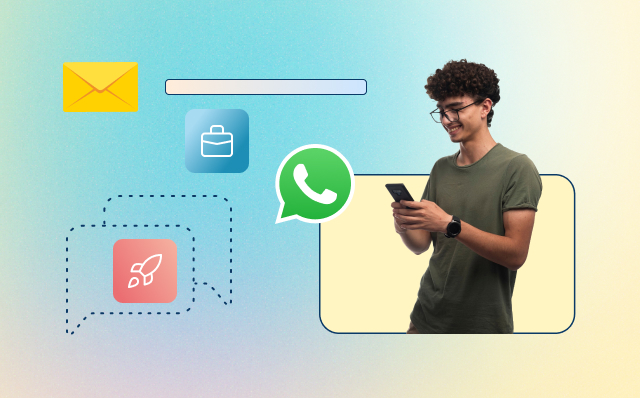In the fast-paced digital world, communication is the key to success for businesses of all sizes. As we enter 2025, messaging trends are evolving rapidly, driven by technological advancements, changing consumer behaviors, and the growing need for personalized interactions. Businesses must stay ahead of these trends to remain competitive and relevant. In this blog, we’ll explore the key messaging trends businesses need to know in 2025 and how they can leverage these changes to enhance customer engagement and drive growth.
AI-Powered Chatbots and Automation
Chatbots are no longer a novelty but a necessity. In 2025, AI-powered chatbots are expected to become even more sophisticated, offering human-like interactions and resolving customer queries in real-time. These bots can handle everything from customer support to sales inquiries, improving efficiency and reducing operational costs.
Key Benefits:
- 24/7 customer support
- Instant responses and improved customer satisfaction
- Reduced workload for human agents
Hyper-Personalization Through AI and Data Analytics
Customers now expect brands to know their preferences and provide tailored experiences. Advanced AI and data analytics enable businesses to personalize messaging based on user behavior, past interactions, and demographics.
How Businesses Can Leverage This:
- Use AI-driven analytics to segment audiences
- Send personalized messages based on browsing and purchase history
- Implement dynamic content strategies for better engagement
WhatsApp as a Primary Business Communication Channel
WhatsApp continues to dominate business communication, especially with the rise of WhatsApp Business API. Companies are using WhatsApp for customer service, marketing campaigns, and even transactions.
Why WhatsApp?
- High engagement rates
- Secure and encrypted messaging
- Rich media support (images, videos, documents, etc.)
Voice and Conversational AI on the Rise
With the increasing use of voice assistants like Alexa, Siri, and Google Assistant, businesses are optimizing their messaging strategies to include voice search and voice-based interactions.
Actionable Insights:
- Develop voice-activated chatbots
- Optimize content for voice search
- Enable voice-to-text customer interactions
Rich Media Messaging for Higher Engagement
Text-only messages are becoming obsolete. Businesses are leveraging rich media formats such as videos, GIFs, carousels, and interactive buttons to create engaging customer experiences.
How It Helps:
- Captures user attention more effectively
- Enhances brand storytelling
- Increases conversion rates through interactive elements
Omnichannel Messaging for Seamless Customer Journeys
Customers expect a seamless experience across multiple platforms, from social media to email and messaging apps. An integrated omnichannel strategy ensures that customers can switch between channels without losing context.
Best Practices:
- Synchronize data across all communication channels
- Maintain consistent messaging and branding
- Use automation to provide seamless transitions
Privacy and Compliance Regulations Impacting Messaging
With increasing concerns over data privacy, businesses need to comply with regulations such as GDPR, CCPA, and new policies introduced in 2025. Customers want transparency in how their data is being used.
Steps to Stay Compliant:
- Obtain clear consent before messaging customers
- Implement robust data protection measures
- Regularly update privacy policies and inform users
Interactive and Transactional Messaging
Transactional messages (like order confirmations, shipping updates, and appointment reminders) are becoming more interactive. Businesses now integrate interactive buttons and quick replies to streamline actions.
Examples of Interactive Messaging:
- Click-to-buy buttons in WhatsApp and SMS
- Appointment booking directly within a chat
- One-click customer feedback collection
Rise of In-App Messaging for Customer Support
Many businesses are integrating in-app messaging features to provide instant customer support without redirecting users to external platforms.
Advantages:
- Faster issue resolution
- Improved user retention
- More personalized support
AI-Powered Sentiment Analysis for Better Customer Insights
AI-driven sentiment analysis allows businesses to analyze customer emotions and tailor responses accordingly. This helps improve customer satisfaction and resolve issues proactively.
How It Works:
- Analyzes tone and sentiment in customer messages
- Categorizes responses based on urgency and priority
- Provides businesses with actionable insights
Peer-to-Peer Messaging and Community Engagement
Customers trust peer recommendations more than direct brand messaging. Businesses are leveraging community-based messaging and peer-to-peer interactions to build brand credibility.
Examples:
- Private brand communities on messaging apps
- User-generated content and testimonials
- Referral-based messaging campaigns
SMS Marketing Evolution with AI-Powered Insights
SMS marketing is not dead—it’s evolving. AI-driven insights allow businesses to optimize SMS campaigns with personalized messaging, automation, and better timing.
Best Practices:
- Personalize SMS content with AI-generated recommendations
- Use short, engaging messages with clear CTAs
- Integrate SMS with other messaging channels for a unified strategy
Augmented Reality (AR) in Messaging
Augmented reality is making its way into messaging apps, allowing customers to visualize products before making a purchase.
Applications:
- Virtual try-ons for fashion and accessories
- AR-based product previews for furniture and home décor
- Interactive AR filters for brand engagement
Sustainability and Ethical Messaging Trends
Consumers are increasingly looking for brands that align with their values. Businesses need to incorporate sustainability and ethical messaging into their communication strategies.
How to Implement:
- Highlight eco-friendly practices in messages
- Use storytelling to showcase brand values
- Encourage sustainable purchasing decisions
The Future of Messaging: What’s Next?
The evolution of messaging doesn’t stop in 2025. Businesses must stay adaptable and keep up with emerging technologies like 5G-powered messaging, blockchain-based security, and AI-driven customer interactions.
Final Thoughts
The messaging landscape in 2025 is more dynamic than ever. Businesses that adapt to these key trends—AI-driven automation, hyper-personalization, rich media, omnichannel strategies, and privacy compliance—will stay ahead of the competition. By leveraging the latest advancements in messaging technology, brands can create meaningful customer interactions, boost engagement, and drive sales. Platforms like Happilee can help businesses implement these trends effectively, offering smart solutions for WhatsApp marketing, automation, and customer communication.
FAQs
1. Why is messaging important for businesses in 2025?
Messaging plays a crucial role in customer engagement, offering businesses a direct and personalized way to communicate with their audience.
2. How can businesses personalize their messaging strategies?
By leveraging AI and data analytics, businesses can create tailored messages based on customer behavior and preferences.
3. What is the role of AI in messaging trends?
AI enhances messaging through chatbots, sentiment analysis, automation, and personalized content delivery.
4. How can businesses stay compliant with privacy regulations?
By implementing clear consent mechanisms, securing customer data, and staying updated on global privacy laws.
5. What is the future of messaging beyond 2025?
Future trends include AI-driven customer interactions, blockchain security, AR-powered messaging, and deeper omnichannel integration.


